Saturday, November 10, 2007
Shri Govardhana Puja
Shri Govardhana Puja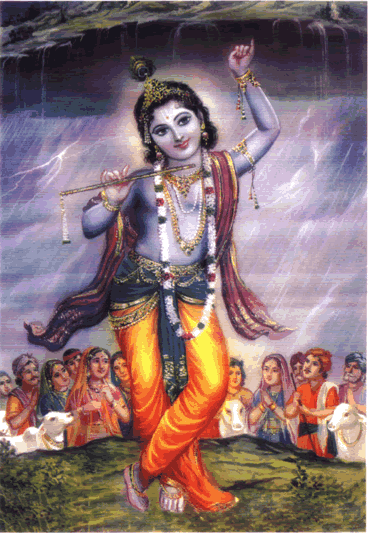
NOTE: The term "Govardhana' has two meanings. The word "Go' means cows, and "vardhana' means nourishment. In the other meaning "Go' stands for senses and "vardhana' means to increase the diversion of the senses towards Sri Krishna. Both these jobs are done by Sri Giriraja. He kindly blesses the devotee by increasing his devotion. Thus by residing in the foothills of Sri Giriraja, all the senses and their respective duties of a soul attain divinity and are inclined to serve the Lotus Feet of Krishna.
Origin of Govardhan: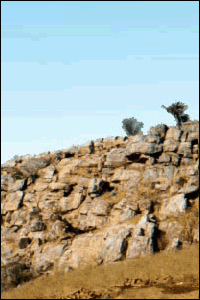
In the western coast of India, in the island of Salmali, lived Dronachala, the king of the mountains. Once a sage by the name of Pulastya Muni, came to him to take his son Giriraja with him to Kashi (Varanasi). After offering some initial resistance, Giriraja, somehow agreed to go with him only on condition that he should not put him down on the earth in between. If he does so, he would stay there forever.
When they were flying over the Vraja bhumi, Giriraja increased his weight to the extent that Pulastya had no option but to put him down. Pulastya understood the mischief of Giriraja. He became furious and cursed him that he would decrease by a grain everyday. But then repenting on the curse he gave to Giriraja, he assured him that he would be blessed in the Dvapara Yuga and everybody would start worshipping him since then.
This happened in the Satya yuga. Brahmaji wished to create the Dvapara Yuga but because of the portentous phenomenon of Ravana, he had to create the Treta Yuga. In this yuga, Hanumanaji on the instructions of Lord Rama, came to take Giriraja for the cause of constructing a pull on the ocean.
Giriraja at once agreed to go for the service of Lord Rama. But before they reached, the pull was ready and there was no need of additional stones. Giriraja was very dissappointed on not having the darshana of Lord Rama.
On knowing the sorrow of Giriraja, Lord Rama sent a message saying that, "...by the end of the Dvapara Yuga, the Supreme Personality of Godhead, Sri Krishna will Himself appear and play on you and will also worship you. In the kaliyuga, the devotees shall attain numerous divine supernatural powers by worshipping you.''
In Sarasvata Kalpa, i.e. the end of the Dvapara Yuga, Bhagavan Sri Krishna stopped the worship of Indra and started the Govardhana Puja by doing Himself. It was a wonderful sight. Being worshipped by Sri Krishna, Giriraja himself became like Sri Krishna. It was like He (Sri Krishna) worshipping Himself. Since then all the six seasons resided permanently on Giriraja.
Besides this, the eight gates of the Asta Sakha's from where they entered the nitya lila, are also on the Govardhan hill. The Asta Sakha's, who reside on the Govardhan hill are in differrent places, each of which were passionately attached to their respsctive Deities of those places.
______________________
About Govardhan Puja In brief: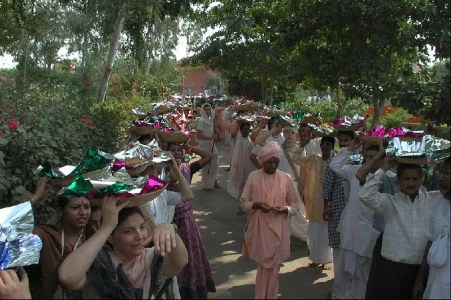
The day after Deepawali is celebrated as Govadhan Puja when Mount Govardhan, near Mathura, is worshipped. Pious people keep awake the whole night and cook fifty-six (or 108) different types of food for the bhog (the offering of food) to Krishna. This ceremony is called ankut which means a mountain of food. Various types of food – cereals, pulses, fruit, vegetables, chutneys, pickles, and salads – are offered to the Deity and then distributed as prasada to devotees.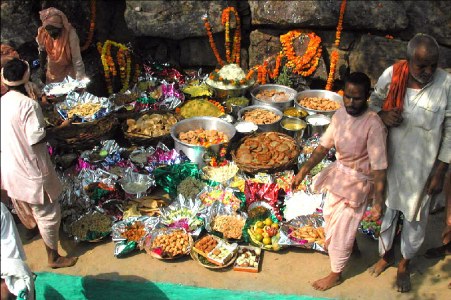
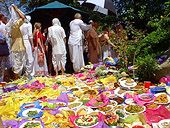

This festival is in commemoration of the lifting of Mount Govardhan by Krishna. According to a legend, before Krishna was born, Indra, the god of Rain, was the chief deity of Vraj. Then Krishna instigated the people to stop worshipping Indra. Indra wanted to show his power over Krishna and brought about a cloud-burst which flooded the countryside for many days. People were afraid that the downpor was a result of their neglect of Indra. But Krishna assured them that no harm would befall them. He lifted Mount Govardhan with his little finger and sheltered men and beasts from the rain. This gave him the epithet Govardhandhari. After this, Indra accepted the supremacy of Krishna. (Shakti M Gupta. 1991. Festivals, Fairs and Fasts of India. Pages 145-146.)
Replicas of Govardhan Hill are made by devotees all over the world and worshipped in the same way as at the original Hillside, Govardhan Silas are bathed and honoured by devotees also, it is a wonderful festival.
________________________
Sri Govardhan Hill Parikrama:
Govardhana Hill was about 16 miles (29 km) high 5,000 years ago. Govardhana is formed in the shape of a peacock. The following places; Radha Kunda and Syama Kunda are the eyes, Dan Ghati is its long neck, Mukharavinda is the mouth and Punchari is its back and tail feathers. As a peacock often curves its neck and puts his head under its stomach. Govardhana Hill is shaped in this pose of a peacock.
Due to the curse of Pulastya Muni, it is sinking the height of a mustard seed daily. In Satya Yuga, Pulastya Muni approached Dronacala, the king of the mountains, and asked him for his son Govardhana. Dronacala was depressed and pleaded the sage that he was unable to bear the separation from his son. Govardhana then went with sage, under the condition that wherever the sage would put him down, he would remain.
Pulastya Muni then took Govardhana and then started for his ashrama. While passing through Braja Mandala he put Govardhana down to answer the call of nature. On his return he found that he cannot move Govardhana. He became very angry and then cursed Govardhana to shrink to the size of mustard seed daily. At that time it was 115 km (64 miles) long, 72 km (40 miles) wide and 29 km (16 miles) high. Now the hill is only 80 ft. high at the highest point.
Another story about Govardhana Hill is that the monkey army of Lord Rama was carrying different stones to construct a bridge to Lanka. Sri Hanuman was carrying Govardhana from Himalayas to help built the bridge. As Hanuman was carrying Govardhana over Vraja, Nala and Neela, who were incharge of building the bridge declared that it was completed and no more stones were needed. Hanuman was in Vraja Mandala and he put Govardhana there. Thus it would appear that Govardhana was then lost in two ways. He was away from Lord Shiva and Lord Rama. Sri Rama heard about Govardhana crying and said that in Dwarpara Yuga he would make His appearance as Sri Krishna and would have His pastimes in that place, and would hold Govardhana up for seven days and nights to save the residents of Vraja.
Lord Krishna lifted "Govardhana Giri" (this huge hill) with his little finger of His left hand, and gave shelter to people under that huge hill from a big storm presented by Indradev. A Parikrama (that is going around the hill) is a sacred worshiped performed by many devotees. It is approximately a 24-mile Parikrama. Govardhana is set along the edge of a large masonry tank known as the "Manasi Ganga", believed to have been brought into existence by the operation of the divine will. Close by is the famous red sandstone temple of Haridev and the Kusum Sarovar.
The parikrama starts by taking bath in Manasi Ganga. One then takes the darshan of Harideva, Manasi Devi and Brahma Kunda. 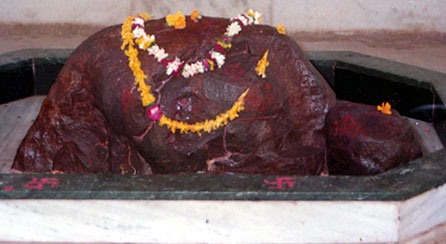
The actual circumbulation of the Govardhana Hill starts from this point. There are eleven main Silas on the Govardhana parikrama like bhuma sila, sindura sila, etc, that have some special significance. One of them is the dasavati sila. Knowingly or unknowingly if anybody commits a sin then he should pay obeisance to Sri Girirajaji over here.
The sacred tank known as Rinamochana Kunda is near the Govardhana power station and according to shastra if one bathes in this kunda they are freed from all vices, usually only after it rains will there be water in this kunda. There are several important places in the vicinity of Govardhana Hill, which are not visited on the normal parikrama. Many of these places are close to Govardhana Hill (within 5 km) and can be visited by taxi easily. Some devotees prefer to walk from each place and spend many days in the area doing so.
Nearby is Papamochana Kunda. It is said that anyone who bathes here has all his offenses removed. After this normally one returns to the road to Mathura and then goes in the direction of Mathura, passing the government bus stand on the right. Here is a small hill on the right, and next to this hill is a small pond - Indra-dhwaja Tila. This is where the cowherd men would normally come to worship Indra.
Govardhanaa hill puja proper:
As previously mentioned within this page, during the Dwapara Yuga, Lord Sri Krishna convinced the cowherd men to worship Govardhana, instead of doing a sacrifice to please Lord Indra, the king of heaven, who is in charge of the rain. His reasons for discouraging the sacrificial ceremony to please Lord Indra were twofold. First, as stated in the Bhagavad-gita there was no need to worship the demigods for any material advancement. Secondly, whatever temporary result one derives is actually granted by the permission of the Supreme Personality of Godhead. This act of stopping his puja angered Lord Indra and in return he sent torrents of rain upon Vrindavan. The residents approached Lord Krishna for help. It was then that Sri Krishna then lifted Govardhana Hill and held it over the residents like a giant umbrella. Seeing extraordinary mystic power of Krishna, Indra, was thunderstruck and immediately called for all the clouds and asked them to desist. He then worshipped Lord Krishna. Since Lord Krishna is worshipped, His Land Vrindavan and Govardhana Hill also need to be worshipped. Since then, Govardhana puja has been going on. In all the temples of Vrindavana huge quantities of food are prepared in this ceremony and are distributed to general public. According to the Vedic scriptures Giri Govardhan is greater than even the transcendental kingdom of Vaikuntha, the eternal abode of Lord Vishnu.
____________________
The Sacred Tongue of Govardhan Hill at Radha Kunda
Sri Giriraja's Tongue as normally seen
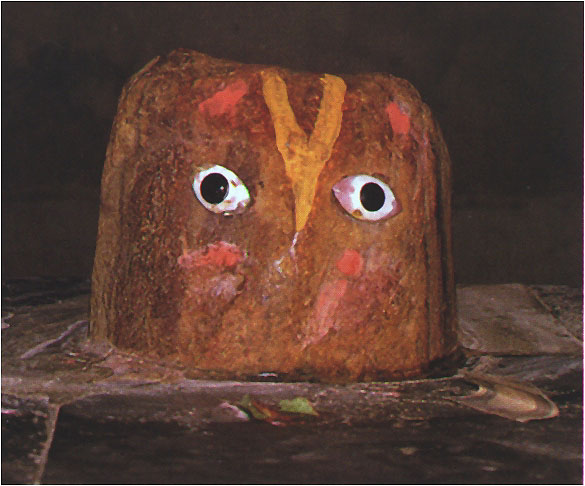
While circumbulating Radha Kunda - Shyama Kunda, one can do the darshana of Sri Giriraja's tongue. At Radha Kunda - Shyama Kunda, you can also have the darshana of the five Pandava's and the Narayana tree. This is also the place where Radha and Krishna enjoyed their pastimes in the Jhulan (swing). There is also a Kadamba tree whose branches are in the shape of a Mridanga (Pakhavaja - an instrument played while singing kirtans). Near to this are the ponds of the Astha-Sakha's. At this spot is where you can get the darshana of the Lotus Feet of Sri Giriraja.
_______________________
Sri Giriraja's Mouth at Manasi Ganga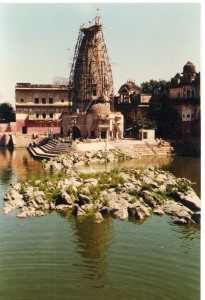
On the banks of the Manasi Ganga is a temple of Sri Giriraja, who appear in the shape of a mukuta. One should bathe Him with milk and offer bhoga. According to legends it is said that one can attain highest fruits in life by circumbulating Sri Giriraja and by drinking the waters of the Manasi Ganga.
What is the reason it is called Manasi Ganga?
Sri Krishna killed a demon by the name of Vatsasura. His sakha's told him that you have killed a cow. You will have to bathe in the Ganges to purify yourself. So Krishna mentally (manasa) produced the Ganges to bathe in it.That is why it is called as Manasi Ganga. At Manasi Ganga, Sri Giriraja is submerged in the water.
The village Govardhana comes twice during the parikrama. Every year there is a big fair held over here on Diwali. At that time thousands of devotees burn and float the candle-lights in the waters of the Manasi Ganga. There is a great importance of having bath in the Manasi Ganga on Diwali. It is said in the Puranas that the Manasi Gangi is milky in colouration. One who has bath in it for six months continuosly is blessed with the divine vision of the milky Manasi Gangi.
Here you will need to express great tolerance and transcendental vision, as the pandas who perform the pujas are somewhat over zealous. Best is to go there with the idea that you are giving to the Lord and His devotees and have a bundle or two of two Rupee notes at the ready, as all pujas here have a fee.
______________________
Govinda Kunda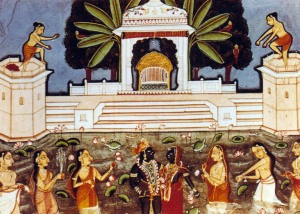
Sri Govindadevaja is also one the four vyuha who was incarnated with Srinathaji for His pastimes. In the Sarasvata Kalpa, Indra had performed the Govindabhisheka of Sri Krishna over here. Once, Sri Krishna had a bath with all the vrajabhakta's in this kunda. Sri Radhika was on the left while Sri Chandravali on the right of Sri Krishna along with their particular groups (left wing or right wing). But while bathing, the hands of Sri Swamini as Radha is known here, and Sri Krishna got separated so they could not bathe fully with all the vrajabasis.
At that time Srimati Yamunadevi was also present there. On request of all the vrajabasi's, they both had bath with all of them giving immense joy. During this the water of the kunda became milky coloured as it remains today.
____________________
Dhoka Dauji - Lord Balaram's place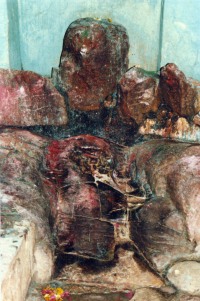
Lord Sri Balarama used to hide and watch the divine sports of his younger brother, Krishna from this place. This is also the place where Krishna took rest in the afternoon while grazing the cows. Once Lord Balaram fell unconscious after having the darshana of the Rasa lila here. At that time his mukuta and stick fell on Giriraja. Sri Giriraja is so delicate that the marks of the mukuta and stick became inscribed on him.
Go Puja - Go Krd - Go Raksha
Worship and protection for the Cows.
____________________
Lord Kåñëa, as the teacher of human society, personally showed by His acts that the mercantile community, or the vaiçyas, should herd cows and bulls and thus give protection to the valuable animals. According to småti regulation, the cow is the mother and the bull the father of the human being. The cow is the mother because just as one sucks the breast of one's mother, human society takes cow's milk. Similarly, the bull is the father of human society because the father earns for the children just as the bull tills the ground to produce food grains. Human society will kill its spirit of life by killing the father and the mother. It is mentioned herein that the beautiful cows and bulls were of various checkered colors—red, black, green, yellow, ash, etc. And because of their colors and healthy smiling features, the atmosphere was enlivening. (A.C. Bhaktivedanta Swami Prabhupada. Srimad Bhagavatam 3:2:29. purport.)
pitä-mätä märi' khäo——ebä kon dharma
kon bale kara tumi e-mata vikarma
"Since the bull and cow are your father and mother, how can you kill and eat them? What kind of religious principle is this? On what strength are you so daring that you commit such sinful activities?"
PURPORT
Everyone can understand that we drink the milk of cows and take the help of bulls in producing agricultural products. Therefore, since our real father gives us food grains and our mother gives us milk with which to live, the cow and bull are considered our father and mother. According to Vedic civilization, there are seven mothers, of which the cow is one. Therefore Çré Caitanya Mahäprabhu challenged the Muslim Kazi, "What kind of religious principle do you follow by killing your father and mother to eat them?" In any civilized human society, no one would dare kill his father and mother for the purpose of eating them. Therefore Çré Caitanya Mahäprabhu challenged the system of Muslim religion as patricide and matricide. In the Christian religion also, a principal commandment is "Thou shalt not kill." Nevertheless, Christians violate this rule; they are very expert in killing and in opening slaughterhouses. In our Kåñëa consciousness movement, our first provision is that no one should be allowed to eat any kind of flesh. It does not matter whether it is cows' flesh or goats' flesh, but we especially stress the prohibition against cows' flesh because according to çästra the cow is our mother. (A.C. Bhaktivedanta Swami Prabhupada. Sri Chaitanya Charitamrta Adi-lila 17:154. text and purport).
"According to the Vedic social system, as soon as one takes birth he becomes indebted to so many persons. We are indebted to the åñis, or great sages, because we derive knowledge from their transcendental writings, such as the Çrémad-Bhägavatam, compiled by Çréla Vyäsadeva. The authors of the scripture know past, present, and future, and we are urged to take advantage of such invaluable knowledge. Thus we are indebted to the sages.
We are also indebted to the demigods, for they manage the affairs of the universe, supplying it with every essential—sunshine from the sun-god, Sürya; moonshine from the moon-god, Candra; air from Väyu; and so on. Each element is controlled by a particular demigod.
We are also indebted to ordinary living entities from whom we take service. For example, we take milk from the cow. According to Vedic understanding, the cow is considered one of our mothers because we drink her milk, just as at birth we drink our mother's milk. The Çrémad-Bhägavatam lists seven mothers: our own mother, the wife of our teacher or spiritual master, the wife of a brähmaëa, the wife of the king, the nurse, the cow, and the earth. We are indebted to all seven of these mothers, and also to our father, brothers, friends, relatives, and forefathers."(A.C. Bhaktivedanta Swami Prabhupada. Second Chance book - chapter 17 "The Moment of Truth")
"Similarly, this Bhagavad-gétä is the essence of all Vedic literature, just like milk is the essence of the blood. Blood... The milk is nothing, but it is cow's blood transformed. Just like mother's milk. The mother's milk, wherefrom it comes? It comes from the blood, but transformed in such a way that it becomes nutritious to the child, tasteful to the child. Similarly, cow's milk also, a most nutritious and valuable food. So it is compared that this Bhagavad-gétä is the milk of the cow of Vedic literature. And the milkman is Kåñëa Himself. And the drinker of the milk is..., we are, Arjuna, through Arjuna. So these things are there." (A.C. Bhaktivedanta Swami Prabhupada. 3rd June 1968. Bhagavad Gita lecture. Montreal.)
"Personified dharma, he's inquiring from the cow. He's addressing cow, amba. Amba means mother. So cow is our mother. Why mother? Because from practical point of view, we drink milk. So how mother... How cow is not mother? She's mother. We are taking her milk. There are seven mothers according to Vedic civilization:
ätma-mätä guroù patné
brähmaëé räja-patnikä
dhenur dhätré tathä påthvé
saptaitä mätaraù småtäù
Real mother, from whose womb we have come to this world, real mother, ätma-mätä. Then guroù patné, wife of the teacher or spiritual master, guroù patné. Brähmaëé, the wife of a brähmaëa. Ätma-mätä guroù patné brähmaëé räja-patnikä, and the wife of the king, or the queen. She's also mother. Dhenu, the cow. Cow is also mother. And dhätré means nurse. Nurse is also mother. Tathä påthvé, and the earth, the earth is also our mother. That we say in country, in the country which we take birth, we say deça-mätåkä. In Sanskrit it is called deça-mätåkä. That is also mother. Mother land, mother language. So this... So many mothers we have got, out of which, cow is also mother. Therefore she's addressed as amba. Amba means mother. Still in Gujarat province, they call amba. And in U.P., United States, er, United Province, in India, they also call amba, or in a broken language they call amma. Still... That is from very long time, mother is... Amba-devé. There is a... From Amba-devé, there is a big temple of Mother Durgä, Kälé, in Bombay. So this Amba-devé was pronounced by the Englishmens as Bamba-devé, and from Bamba-devé it has come to "Bombay." Actually, there is a big temple of Amba in Bombay. From that name, instead of Amba, they have become Bamba. Just like from Sindhu, they have called, they have designated the inhabitants of Sindhu-deça as "Hindu." The Muhammadans, they pronounce s as h. So from "Sindhu," it has come to "Hindu." Otherwise, this "Hindu" name is not mentioned in any Vedic literature. It is given by the... This name is given by the other foreigners. Especially the Arabian countries, they used to call this nation, Bhärata-varña...
Actually, Hindu is not a religion. Hindu is a name given by the foreigners. The religion is, of India, varëäçrama-dharma, following the institution of four varëas and four äçramas. That is varë... Or sanätana-dharma. Sanätana-dharma means eternal, eternal religion. Religion of human being is one. That is called sanätana. A living entity is described as sanätana. Mamaiväàço jéva-bhüto jéva-loke sanätanaù. In the Bhagavad-gétä you'll find sanätanaù, and Kåñëa is also addressed in the Eleventh Chapter as sanätanas tvam. And there is another place, or spiritual world, which is also called sanätana. In the Bhagavad-gétä you'll find, paras tasmät tu bhävo 'nyo 'vyakto 'vyaktät sanätanaù. So this sanätana term is very important. The living entity is sanätana and God is sanätana and the spiritual world is sanätana, and the process by which your lost relationship with God established and you go back to home back to Godhead, that is called sanätana-dharma. Sanätana-dharma. That is our eternal relationship with God." (A.C. Bhaktivedanta Swami Prabhupada. 15th January 1974. Srimad Bhagavatam lecture SB lecture SB 1:16:19. Hawaii).
Bhaidhuj: (Bali-Daityaraj-Puja)
When Lord Vamandev was pleased with Bali maharaj and appeared in Vishnu-rupa, Bali asked a boon that Lord Vishnu would be on every door at Patalaloka because in Nether regions Bali wants his society Lord Vishnu agrees and goes to become a Dwarpalaka of Bali. Narad tells Laxmi where Lord Vishnu is. Laxmi plays trick on Bali - she goes to Bali as a poor woman seeking help - with her she takes raksha bandan. She says to Bali that she doesn't have a brother - and would dearly like one. When the raksha bandan is tied the brother has to offer her something. Bali asked Laxmi what he can give her, Laxmi replied that you have my everything in your service - please release Lord Vishnu.
As Yama's sister is Yamuna and she fed Yama to his satifaction he said that from now on any brother who visits thesister on Bhaidhuj day will escape the hand of Yamaraj - the sister prays for her brother.
Brother goes to sister's house – the very best of foods are cooked, and then the sister feeds brother.
There is another significance to this day culturally: The last festival associated with Deepawali is Bhaya Dhuja, popularly called Tikka in Punjab. In Vedic times, it was called Bhartri-dwitiya. Two days after Deepawali, women and girls apply saffron and rice grains to the foreheads of their brothers to protect them from evil and to wish them long life and prosperity. The brothers in turn give the sisters presents. In Uttara Pradesh and Harayana, the tikka is usually a paste of vermilion with rice grains in it.
A red mark on the forehead is reminiscent of Shiva's third eye and is believed to keep the evil away and thus protect the wearer. With constant wars in North India, the custom of applying a tilak to the forehead of men going to war assumed an aided significance. Mothers, wives and sisters applied tilak to the men to protect them from harm. (Shakti M Gupta. 1991. Festvals, Fairs and Fasts of India. Page 146.)
Yama Dwitiya:
During the month of Karttika, the business community observes Yama-dwitiya by worshipping Yama, the god of Death, his scribe Chitragupta, his messanger Yamaduta, Ganapati and the river Yamuna. Om this occasion, the royal seal, the pen and the inkpot are also worshipped. Sisters prepare food for their brothers and, if the brother has this food sitting on the banks of the river Yamuna, on Yama-dwitiya day, it is believed to give him and his sister's husband a long life.
Yama and Yami, goddess spirit of the river Yamuna, were twins born to Surya, the Sun god and his wife Samjna. According to a legend, Yama was lame and the cause of this disability was a curse pronounced on him by his step-mother, Chhaaya. Samjna, finding the effulgence of her husband Surya excessive, went away and in her place left her shadow Chhaaya. The physical likeness between Sa,jna and Chhaaya was so marked, that Surya had no reason to suspect her. One day Yama kicked his step-mother Chhaaya for being partial to her own children. At this Chhaaya cursed him and said that the leg that kicked her would be full of worms. Surya heard the curse and, realising that a mother would never curse her own children, suspected the identity of Chhaaya and went in search of his real wife, Samjna.
Yami, Yama's twin sister, was transformed into the sacred river Yamuna in whose purifying waters people bathe on holy days. Yama was given an equally important role and made the god of Death, whom all fear. (Shakti M Gupta. 1991. Festvals, Fairs and Fasts of India. Page 146.)
-----------------------------------------------------------------------------------------------------
SRI RASKIKANANDA DEVA GOSVAMI
In the Christian year 1590 (Sakabda 1512), on the first day of the bright fortnight of the month of Kartik, during the night of the festival Dipamalika, when the houses are decorated with rows of lamps, Sri Rasikananda Deva made his appearance in this world. His father was Sri Acyuta Deva, the king of Rohini. After passing many years without having a male issue, Sri Acyuta Deva, by the mercy of Sri Jagadisa (Jagannath), was blessed with this jewel of a son. The village of Rohini or Royni was situated within the country known as Mallabhumi, encompassed on one side by the Suvarnarekha River (Suvarna meaning golden and rekha, a line). This Suvarnarekha River cleansed the sins of all the local people. Near Royni was another village of the name Barayita, by the side of which flowed the Dolanganadi River, whose banks were adorned with beautiful gardens. Raja Acyuta Deva very affectionately maintained his subjects and was famous for impeccably observing the rites attendant upon kings. In the village of Royni the son of King Acyuta appeared as the sun appears in the eastern sky and became dearly beloved by the people. He was known as Rasikananda and also Murari. As he grew up, shining qualities appeared by degrees in his person that caused the further exaltation of his family, just as the waxing moon gradually expands its influence in the night sky and causes the sea to rise. At a very young age he became quite proficient in all of the scriptures. He was very devoted to his parents, especially his mother, whose name was Bhavani. His father married him at very young age. Murari's wife Syamadasi was a mine of good character who hailed from the village of Ghonta Sila, not far from Royni on the banks of the Suvarna Rekha, where in days of old the Pandavas had lived in exile. One day, Murari was sitting in a lonely place, wondering when and where he might become so fortunate as to get shelter at the lotus feet of a spiritual preceptor. Just then a voice from the sky addressed him, "Don't be in anxiety, you will become the disciple of Sri Syamananda." Having heard this proclamation, Rasik Murari became very jubilant, and began to repeatedly murmur the name Syamananda, as though chanting japa. From moment to moment his eagerness increased without diminition, as tears flowed from his eyes by his chanting of the name of Syamananda. He was in such a state that he spend most of the night sleeplessly, calling to his master Syamananda. Finally, towards the early morning, he drifted off to the land of dreams, where he saw his spiritual master, the very figure of charm and grace. Smilingly, Syamananda informed him, "When tomorrow the eastern sky becomes tinged with pink, you will obtain me." Saying this, Syamananda disappeared. Rasikananda's heart began to swell in ecstatic bliss. Then, with the first rays of morning which dispel the dense darkness of the world, the wise Murari sat silently watching the path. After some time Syamananda approached from the distance, looking as beautifully effulgent as the sun and surrounded by his disciples like Sri Kishora dasa and others. His smiling face was like the lotus flower that opens to greet its friend the sun, and his chest was as broad as a door. His captivating appearance was made all the more irresistable by the sweet sounds of 'Sri Krsna Caitanya-Nityananda' emanating from his lotus mouth. Absorbed in intense love he moved along the path like the clouds move in the sky. When Rasika caught sight of this divine form, he fell down in front of him to touch his lotus feet. In great ecstasy Shyamananda embraced him and began to bathe him with his tears of ecstatic love. Sri Rasika Murari then felt himself to be one of the most fortunate living beings within this universe.
On an auspicious day Syamananda initiated Rasika and his wife in Radha-Krsna mantra. After that, Rasikananda began to travel with his guru, during which time he became a very intimate disciple. Syamananda then bestowed upon him the service of Sri Radha- Govinda Deva at Sri Gopiballabhapur. Rasikananda became totally engaged in their Lordships service, and the devotees were charmed by his excellent services. At Gopiballabhpur and other places he began to seriously take up the preaching of the message of Sri Gaura-Nityananda. By his influence many atheists and unbelievers were transformed into devotees of Sri Gaura-Nityananda. "By the tremendous influence of Rasikananda's preaching, many rogues, robbers and atheists were delivered from their sinful activities and received his mercy. He distributed the jewel of devotion even to the infidel Mohammedans, as he travelled from village to village, in the company of his disciples. He even converted the wild elephant which was sent for his destruction into his disciple and engaged him in the service of Krsna and the Vaisnavas. That wicked miscreant who sent the elephant, a Mohammedan, bowed at his feet when he realised his mistake. It is not possible to count the number of living entities that were extricated from the ocean of material existence by Rasikananda Deva's association. He was always intoxicated with the chanting of the Holy Name. Who cannot but be overwhelmed by hearing about his uncommon qualities?" [B.R. 15.86] By Sri Rasikananda's mercy many Mohammedans, who were actually just impious and wicked atheists, became worshipers of the Supreme Lord. Also many virtuous kings and zamindars such as the king of Mayurbhanj named Vaidyanatha Bhanj, the king of Patashpur known as Gajapati and Candrabhanu, the king of Moyna, took shelter at his lotus feet. What to speak of those pious and noble gentlemen, even the sinful zamindar Bhima, the Mohammedan Suba Ahmadbeg and the wicked atheist Srikar also surrendered themselves at his lotus feet. A vicious, wild elephant was tamed by Rasikananda's transcendental influence and henceforward was known as Gopala das. Later, two jungle tigers likewise gave up their ferocious nature. Accepting the order of his guru, Sri Syamananda, on his head, Rasikananda preached the message of Sri Gaursundar in the world for approximately 16 years. Thereafter he entered into his eternal pastimes through the lotus feet of Gopinatha at Remuna. On the first day of the bright fortnight in the month of Phalguna, Sakabda 1574 (Christian year 1652), Rasikananda quietly slipped out of the village Santa without anyone's notice and walked to Remuna. Arriving there, he discussed Krsna-katha with the devotees there for a while and instructed everyone to serve Sri Krsna with devotion. Then, after requesting them to begin sankirtana, he entered the temple of Sri Gopinatha, and after touching Kshira-chora Gopinatha's lotus feet, which bestow complete fearlessness, he entered into their ultimate shelter.
Rasikananda prabhu's samadhi is at the Temple of Kshira-chora Gopinath at Remuna just in front and to the right as you go in the main gate, with the temple to the left, and admin' offices straight ahead.
Sri Rasikananda had three sons: Sri Radhananda, Sri Krsna-Govinda and Sri Radha-Krsna. The present servants of Sri Sri Radha-Govindadeva at Gopiballabhapur are their descendents. He composed Sri Shyamananda-sataka, Srimad Bhagavatastaka as well as other hymns and songs. His Sripat Gopiballabhpur can be reached from Calcutta by taking a train to Khavagpur, and a bus to Gopiballabhpur from there. There is also a temple of Rasikananda at Puri. One year, during Lord Jagannatha's Ratha-yatra festival, Rasikananda Deva was preaching somewhere in the country, but when he realised that it was time for Ratha-yatra he dropped everything and rushed like the wind in order to come to Nilacala in time for the festival.
But in the meantime the festival had already begun. Lord Jagannath, Who felt reciprocal separation from His dear devotee Rasikananda, caused the Rath to stop. Though the king summoned his elephants to push the Ratha, under no circumstances could they budge it, not even an inch. Then Lord Jagannatha, seeing that the king was becoming frustrated, informed him that he was waiting for His devotee Rasika. Finally Rasikananda Deva arrived, carrying with him many offerings of silk clothes and other presents. He fell down to offer his dandavats before Lord Jagannatha, and the king requested him to pull the rope at which the cart began to easily move along the road, just as the clouds move in the sky. Later the king requested Rasikananda to accept a gift of land so he might establish a temple there. Rasikananda requested the place known as Fultota Math, which is now known as Kunja Math. There he installed the Deity of Sri Bat Krsna. The Deity is now known as Sri Sri Radha-Rasika Raya.
_____________________
Orignal From: Shri Govardhana Puja

No comments yet